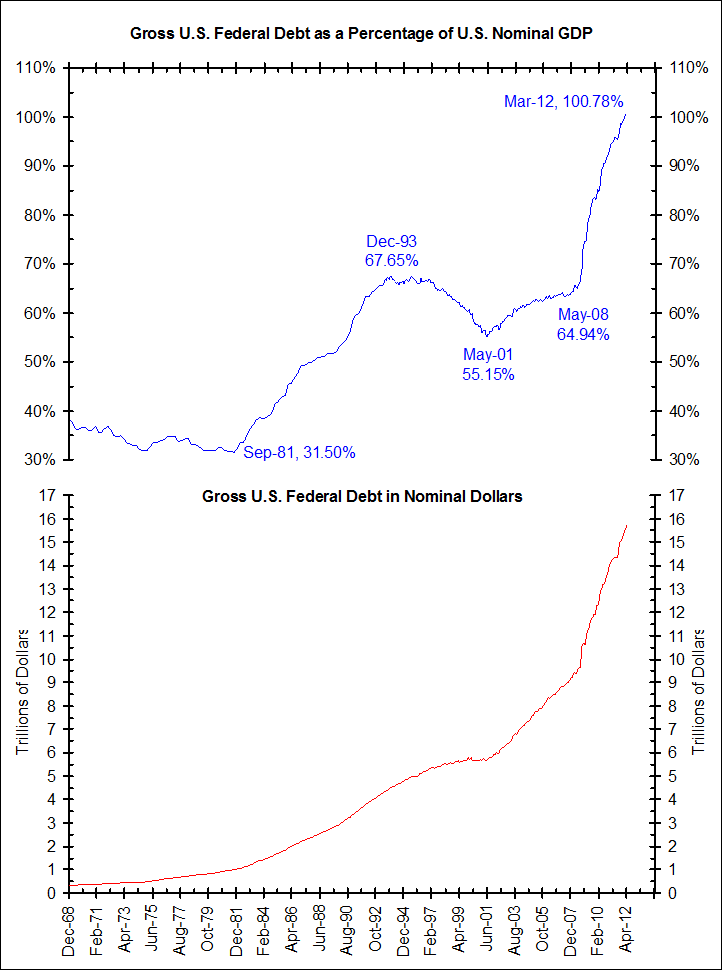MarketBeat (WSJ Blog) – The U.S. Debt Load: Big and Cheap
The U.S. debt overhang gets a lot of attention. And well it should, at roughly $15.88 trillion, the total public debt is bigger than the entire 2011 output of the economy. GDP was $15.094 trillion in 2011. (Although a hefty amount of the debt — $4.811 trillion — is actually owed by the government to itself, in the form of holdings in government trust funds that pay for stuff like social security.) Not including the debt the government owes itself, the debt-to-GDP ratio is roughly 73%. But including the debt held in government accounts, the ratio is about 105%. Either way, it’s the biggest debt load the country has had since World War II. That’s due to both the shrinkage of the overall economy — because of the terrible financial crisis/recession — and the increases in Federal spending, aimed in part at supporting the economy. By way of comparison, Moody’s lists troubled European countries such as Italy and Spain as having debt-to-GDP ratios of 120% and 69% at the end of 2011, respectively.
Press TV – Euro government debt hits record high
The average debt load of the 17 countries using the euro currency has hit a record high – over 88 percent of GDP. This is according to a new report of the EU statistics agency, Eurostat. The biggest offender is Greece, the epicenter of Europe’s economic crisis. Greek debt now amounts to a staggering 132.4 percent of national output, a level seen as unsustainable. This has renewed concerns that Greece may default in the coming months. Analysts have been warning about this for many months, but little action has been taken. So the effects of contagion are becoming stronger every single day. Fears are growing that although Spain has just secured a bailout for its banks, it may need a full-blown rescue package for the entire country. The contagion has also reached the most stable euro country, Germany. Berlin has just received a stark warning that unless the crisis is stemmed, it may lose its excellent credit rating.
The Financial Times – Getting out of debt by adding debt
“You can’t get out of debt by adding more debt.” How often have you read this sentence? It is a cliché. I am going to argue that, to a first approximation, this obvious, even banal, statement is the reverse of the truth, which is that the only way to get out of debt is to add more debt. What matters is who adds the debt and in what form. To put it more bluntly, it depends on who these“you” are. As I have done in two previous posts on the theme of “balance-sheet recessions”, I am going to focus on the US, because it is the most important country now going through the post-crisis deleveraging process. Let us start with an obvious and crucial fact: at the world level, net debt is zero. For an individual country, net debt is how much foreigners have lent to residents less how much residents have lent to foreigners. In the case of the US, net debt at the end of 2011 was 44 per cent of GDP, roughly an eighth of gross debt. Suppose that all the people who lent and borrowed knew what they were doing: thus they had an unbiased and reasonably accurate appreciation of the future course of incomes and asset prices. Then, barring some huge and unexpected external shock –a world war, for example – the debt some have contracted would create no problem. It would simply reflect improved opportunities for inter-temporal trade in savings. This is, however, not the world we live in. Indeed, if we did live in such a world, huge financial crises would be impossible. If you disagree on that point, I recommend that you read something else.
Source: Bianco Research



What's been said:
Discussions found on the web: